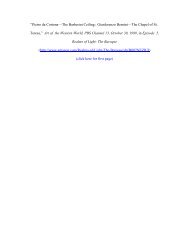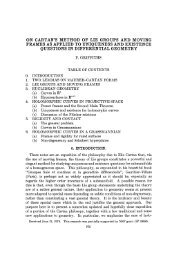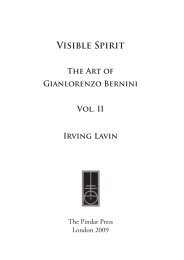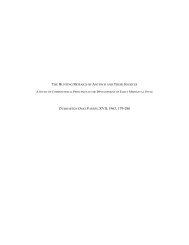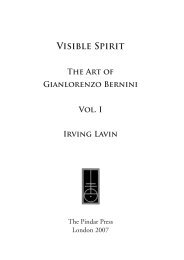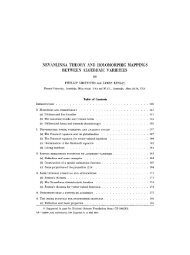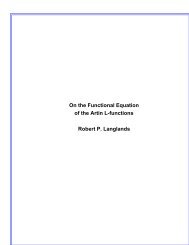View PDF - Project Euclid
View PDF - Project Euclid
View PDF - Project Euclid
Create successful ePaper yourself
Turn your PDF publications into a flip-book with our unique Google optimized e-Paper software.
512 PHILLIP A. GRIFFITHS<br />
One way in which this makes sense is for the individual forms qk to have a<br />
singularity at the origin ofjust the right order to prevent (5.33) from holding (cf.<br />
the proof of (3.17) in 3(b)), but in the alternating sum<br />
k<br />
(-1)<br />
2(n k)<br />
cancellation occurs in the highest order term. If this were the case, then there<br />
would be a procedure for looking into the topological invariance of other curvature<br />
integrals. We note in closing that the question is purely one on the singular<br />
varieties V0,s and might be examined by blowing up the origin in a fashion similar<br />
to how (3.17) was established.<br />
Footnotes<br />
1. cf. the references cited in footnote 2 of the introduction.<br />
2. cf. the reference cited in footnote of the introduction.<br />
3. There is a discussion of the Plticker formulas in the paper cited in footnote 4 of the introduction.<br />
4. The motivation for this terminology is given by the discussion at the end of the preceeding<br />
section 5(a).<br />
5. H. Hironaka, Resolution of singularities of an algebraic variety over a field of characteristic<br />
zero, Annals of Math., vol. 79 (1964).<br />
6. B. Tessier, Introduction to equisingularity problems, Proc. Symposia in Pure Math., vol. 29<br />
(1975), pp. 593-632; this paper contains an extensive bibliography on singularities.<br />
7. Milnor numbers were introduced in Milnor’s book cited in footnote 5 in the introduction.<br />
There is an extensive bibliography on material pertaining to Milnor numbers given in Tessier’s<br />
article referred to in footnote 6 above.<br />
8. Of course the classic source is S. Lefschetz, L’Analysis situs et la gomtrie algObrique,<br />
Gauthier-Villars, Paris, (1924). A recent paper which in fact is pertinent to our present study is A.<br />
Landman, On the Picard-Lefschetz transformations, Trans. Amer. Math. Soc., vol. 181 (1973), pp.<br />
89-126.<br />
9. As noted in 3(a) (cf. (3.7)) the differential forms cn- k(flv,) have the positivity property<br />
which is consistent with the positivity of the right hand side of (5.22). We may ask if the more subtle<br />
positivity<br />
lim lim<br />
--*0<br />
(- 1)kC(k’ n)<br />
is valid?<br />
10. Of course it may happen that A is degenerate, but in view of (3.11) it would seem that this<br />
should be considered an exceptional occurrence.<br />
11. In this discussion, , does not denote the pullback of forms.<br />
12. e.g., the degree will not, but the class will.<br />
13. cf. the discussion in the reference cited in footnote 4 of the introduction.<br />
14. G. Laumon, Degrd de la varidtd duale d’une hypersurface singularitids isolds, Bull. Soc.<br />
Math. France (1976), pp. 51-63.<br />
15. cf. The Fenchel-Fary-Milnor theorem in 2(b) the reference cited in Footnote 7 there.<br />
DEPARTMENT OF MATHEMATICS, HARVARD UNIVERSITY, CAMBRIDGE, MASSACHUSETTS 02138<br />
t k




